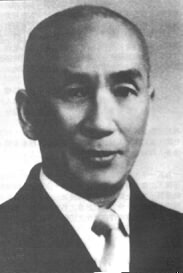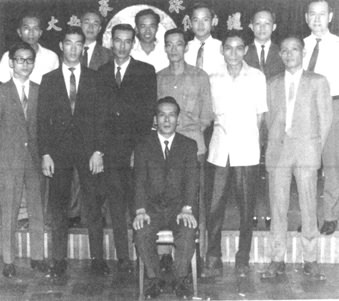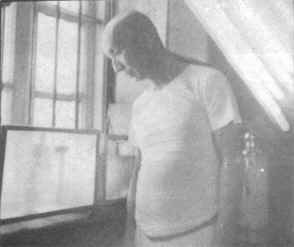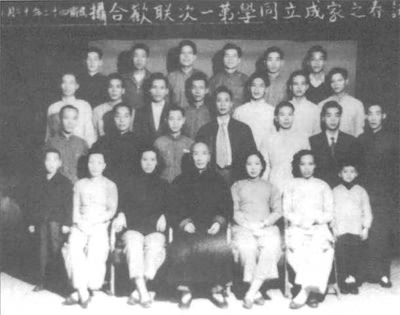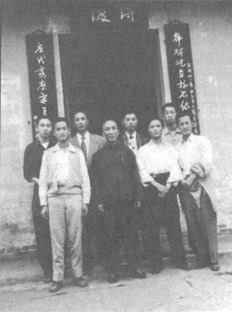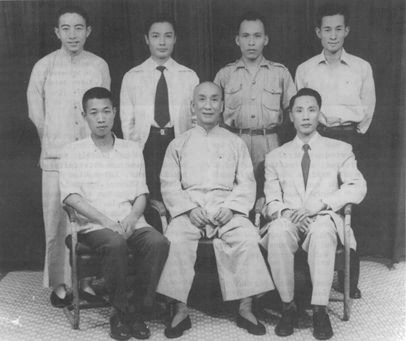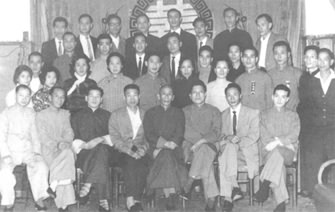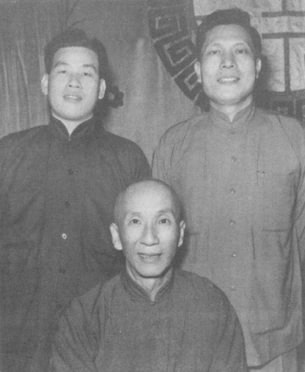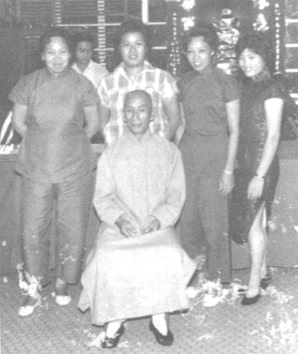
1950 - 1953
In late 1949, Mainland China saw a change of government. Many Mainlanders came to work in Hong Kong. Grandmaster Ip Man of the Ving Tsun Kungfu clan also came to Hong Kong at around this time.
|
|
|
|
The only photograph of Grandmaster Ip Man in a western suit, taken around 1949-1950).
|
|
|
Sifu Lok You and some of his students taken at his birthday party 20 years ago. |
At that time, amongst the staff members of the Association of Restaurant Workers of Hong Kong were Leung Sheung, Lok Yiu and Lau Ming. They were all Chinese martial Arts enthusiasts. The secretary, Tsui Fung, worked with Sing Pao Daily News, and did not have enough time to handle the business of the association. So Mr. Lee Man was employed as an extra helper in assisting with the Association's daily affairs. After work, Mr. Lee Man often did the Huen-Sau (circling hand) exercise. Leung Sheung recognized this as a basic movement of Ving Tsun Kungfu, because he had once learnt Martial Arts from Master Tang Suen of the Weng Chun Kungfu system, and knew something about Ving Tsun. He asked Mr. Lee if he too had learnt Ving Tsun Martial Arts before. There and then Mr. Lee related stories of the deeds of Sifu Ip Man, and everyone present got interested. He then brought Sifu Ip Man to the Association of Restaurant Workers of Hong Kong, and introduced him to everyone. Ip explained the principles of Ving Tsun Martial arts, and won the admiration of all. He was at once invited to teach Kungfu at the Association, and he readily agreed.
|
|
|
葉問宗師曾有一段時間「心廣體胖」。此圖攝於一九五二年。其時,葉師常自詡為當年的日本首相吉田茂。 (徐尚田珍藏) The plump Grandmaster! Taken in 1952, when Grandmaster Ip was putting on weight. He joked that he looked like "Shigeru Yoshida", the Japanese prime minister at that time. (Chu Shong Tin's private collection) |
|
|
|
一九五三年十二月六日,葉宗師與一眾大弟子合攝了此照片。名為「詠春之家成立同學第一次聯歡合攝」。各同門可辦認出多少早期的「大師兄」否 ? (徐尚田珍藏) The "Vingtsun Family" in its early days! A group photo of the "Ving Tsun Family" taken on 6th Dec 1953, at the first family gathering. How many of these young men do you know? Your Si-fu or Si-Kung might be here! (Chu Shong Tin's private collection) |
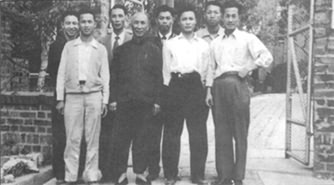
|
The trip to countryside
|
|
|
|
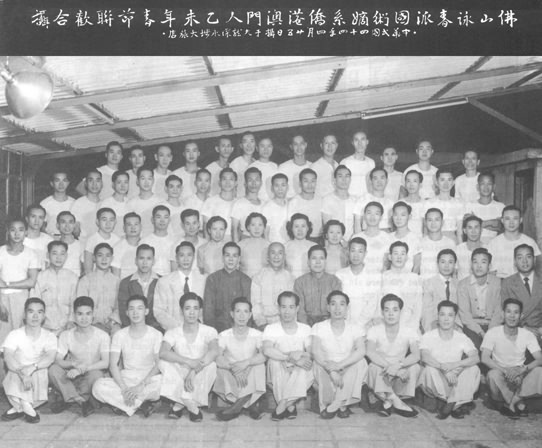
|
|
|
The first class started around May 1950. It was attended by eight people, including Leung Sheung, Lok Yiu, Lau Ming, Tsui Cho, Chan Kau and Chan Sing Tao. Later, eight more joined including Hui Yee, Lee Yan Wing and Tsang Wing, making a total of sixteen. Commemorative photographs were taken.
A few months later, a new class was started. It was a big, busy class with thirty or so people participating. It was agreed that each would contribute eighty cents to cook sweet soup for consumption after practice. Unfortunately, most of them lacked patience and perseverance. In the end, only Leung and Lok remained.
In 1951, secretary Lee Man resigned and took a job at the Nan Hoi Clan Association. The Association of Restaurant Workers of Hong Kong employed Tsui Sheung Tin to take over. Soon, Tsui became interested, and enrolled under Sifu Ip Man. He started the third class in the Kung On Branch Office in Sheung Wan, the mid-west of Hong Kong Island. Response was enthusiastic, more than forty people joined. And the name of Ving Tsun started to spread to the outside. There were also many challenge-fights by the Ving Tsun people to the other Kungfu styles to test their fighting techniques. Later, Ip Man opened other classes at Wah Ying Restaurant in Stanley Street in Central district of Hong Kong Island, and on the roof of a building in Bridges Street (Local people used to call it “Saam-Shup-Guan”, or “Thirty-houses”).
|
|
|
|
People outside the Restaurant trade also came to learn. People such as Chiu Van, Man Siu Hung, Lee Wing, Law Bing, Yip Po Ching, Hui Yin Leung, Law Chung Yin and Ho Kui Wah. Everyone practised hard.
© 1990. Copyright by Ving Tsun Athletic Association Ltd.

1954 - 1960
In 1954, the fourth floor of a Hoi Tan Street building was rented for teaching Martial Arts techniques. A young man named Wong Shun Leung went to Ip’s school and tested the Ving Tsun fighting techniques. Lo Man Kam, who was practising there, accepted the challenge. Then Yip Po Ching took care of Wong. Wong finally enrolled. Wong later became an outstanding Ving Tsun practitioner. Later, Lee Kam Shing and William Cheung joined. Not long afterwards, Ip Man even taught a small group of people at the Sam Tai Tze Temple (The Temple of the Third Prince of Sea-Dragon). Lee Hon and Lee Cheung were amongst the students.

|
|
|
|
Grandmaster Ip Man and Wu Chung, a staff member of the Restaurant Workers' Union, in 1956.
|
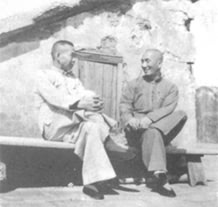
|
|
|
Grandmaster Ip Man at his student Man Siu Hung's wedding party. At that time, Ip's eldest student Leoung Sheung had already started teaching Kungfu, so the photo includes his students as well as Grandmaster Ip's. This photo is believed to have been taken between 1955 and 1957. (Chu Shong Tin's private collection.) |
In 1956, a gymnasium was opened in Lee Tat Street at Yau Ma Tei. Ng Cham, Yip Yin, Wong Kiu, Wong Cze Wing, Choy Siu Kwong, Wong Tsok, Wong Long, Fung Ping Pol, Chan Chi Man, Siu Yuk Man, Bruce Lee and others attended. At that time, Wong Shun Leung often had scuffles with members of other Kungfu clans, and caused a lot of trouble. He fought mostly with people of Chu Gar Tong Long Pai (Chu's Family Praying Mantis Kungfu Style), but in the end the matter was settled peacefully. Then there was the dispute with Pak Hok Pai (White Crane Kungfu Style). Through the mediation of Mr. Chan Yuet Fat (member of the Pak Hok Kungfu clan, also the swimming instructor of Wong Shun Leung's younger brother Wong Man Leung), a dinner-party at Mun Ting Fang Restaurant at Mongkok in Kowloon was arranged, and senior members of the two Kungfu clans were invited to come together. The dispute was thus resolved.
|
|
|
The late Grandmaster and two of his late senior students, Lee Wing (left) and Leung Sheung (right).
|
|
|
|
Grandmaster Ip Man and four of his earliest female students at a birthday party in 1957. From left to right: Lee Ngan foon, She Mei King, Lo Tei, Ah Tim. (Ip Ching's private collection) |
In 1957, Sifu Ip Man moved his Kungfu school to Li Cheng Uk Estate, a housing estate in Kowloon. Ho Kam Ming, Chow Tze Chuen, Mak Po, etc. were students of this period. There was quite a large number of students, and most of them were workers of the bus company. On many occasions, there were challenge-fights and secret contests of martial arts techniques with other Kungfu styles. Fortunately, there were no unhappy incidents. Around this period, Sifu Ip Man also taught two more classes, both in Prat Avenue and Tai Sang Restaurant. Ho Luen, Tam Lai And Koo Sang all started to learn at this time.
© 1990. Copyright by Ving Tsun Athletic Association Ltd.
1961 - 1970
In 1961, the gymnasium was moved to Hing Ip Building on Castle Peak Road. In 1962, the eldest and second son of Grandmaster Ip Man, Ip Chun and Ip Ching, came to Hong Kong from Fat Shan. They studied together with Moy Yat and others.
|
|
Grandmaster Ip Man and his clansmen at his 62 nd Birthday Party. (Ip Ching's private collection) |
|
Grandmaster Ip and Lee Man (also called Lee Tin Pui), former secretary of the Restaurant Workers' Union. Lee Man was instrumental in the development of Ving Tsun kungfu in Hong Kong.
|

|
|
Grandmaster Ip Man and two of his earliest favorate students, Chu Song Tin (left) and Lok Yiu (right), believed to have been photographed between 1966-67. (Lok Yiu's private collection) |
|
The Ving Tsun Kungfu clan was now at the peak of its progress. Many of Grandmaster Ip's students also started teaching and worked together to develop Ving Tsun Kungfu.
In 1964, satisfied with the development of Ving Tsun Kungfu and seeing there were people to succeed him, Grandmaster Ip Man decided not to overwork himself. He wound up the affairs of the gymnasium and switched to teaching by appointment. At that time Grandmaster Ip rented an apartment in Yee Fai Building in Tung Choi Street as his permanent residence. He also instructed his students to organize a general association of the Ving Tsun Kungfu Clan. After years of planning, the Hong Kong Ving Tsun Athletic Association was formally established. Cheung Ning Building, 3/F, 3 Nullah Road was purchased as the Gymnasium premises.
Grandmaster Ip started teaching in Hong Kong in 1950. He passed away in 1972. Twenty three years had flown by, but he had succeeded in popularizing Ving Tsun Kungfu throughout the world. He might well be proud of what he achieved. So might we, as his students and successors.
|
|
One of the very few everyday-life photographs taken around 1968-70. (Chu Shong Tin's private collection) |
|
Leung Ting was the first person to develop Chinese kungfu into post graduate colleges in Hong Kong. In the winter of 1969, Leung held the first V.T. Kungfu contest and Demonstration in Baptist College. Grandmaster Ip Man, Tang Sang, Po Kin Wah, Koo Sang, Wong Chu, Lee Tat Bong, Ng Wah Sum and some other V.T. kungfu clansmen became his guests. He also invited some instructors of the other kungfu styles. In this photo, Leung Ting is kicking his opponent into the air. In the background from left to right are Tang Sang, Grandmaster Ip Man, Lee Tat Bong, Yip Tin Tak (Tai Pai kungfu), Po Kin Wah and Koo Sang.
|
|
|
|
In 1970, Leung Ting moved his school to the old VTAA address on Nathan Road. Here is Grandmaster Ip Man and Leung Ting, when Grandmaster went to congratulate him.
|
|
The VTAA has always been regarded as the headquarters for the Ip Man's Ving Tsun system. Ving Tsun clansmen from all over the world take pride in visiting the VTAA in Hong Kong. This photo was taken during the visit of Nick Smart, headman of British Wing Tsun Organization, to the VTAA in May 1989. From Left to Right: Siu Yuk Men, Leung Ting, Koo Sang, Chu Shong Tin, Nick Smart, Wong Shun Leung, Ip Ching, Yip Yin, Lan Man Hog and Tam Hun Fan. |
© 1990. Copyright by Ving Tsun Athletic Association Ltd.
詠春家族
詠春家族

詠春體育會發展簡介
詠春體育會發展簡介
為發揚詠春拳術及團結門下弟子,詠春派葉問宗師指派七位弟子於1967年在香港創立詠春體育會,為香港最早註冊的國術團體之一。翌年宗師及弟子購置了位於香港水渠道現址作為詠春體育會永久會址及教授詠春場地。
本會數十年來會務蒸蒸日上,海內外會員人數穩步上升,究其原因,不外是本會秉承宗師訓示,不遺餘力地發揚和宣傳宗師傳下的武術,並出版有關書籍及錄影帶等推廣詠春成為當世普及運動以收強身健體自衛之效。
此外,本會持續地聯絡和團結海內外同門及定期舉辦各類活動,例如訓練班、茶座、研討會、表演、比賽、聚餐、遠足、旅遊、拜祭宗師等,不勝枚舉。近年發展有以下顯著例子:
﹝一﹞首屆世界詠春同人大會
1999年11月本會耗費鉅大人力物力在本港主辦首屆世界詠春同人大會,體育界嘉賓,世界各地著名師父及門下弟子等逾800人出席,包括本港、國內、及來自歐、美、加、澳等地同門。 不少葉問親傳及再傳弟子紛紛上台獻技,盡顯詠春拳、刀、棍、樁法之精髓,好評如潮。本會極表滿意及多謝世界同門的支持。散佈世界各地,平日難得一見的同門藉此良機聚首一堂,交流經驗,並拍照留念,在詠春面向世界而言,誠盛況空前的盛事。本會亦攝錄大會珍貴鏡頭,製成VCD在本會發售。 世界同人大會後翌日,本會組織順德佛山武術交流團,參與的本港及海外詠春門人達百餘人,受當局及武林人士熱烈歡迎,賓至如歸。本會接獲不少參與者反映,同人大會及武術交流團甚具價值,相隔數年舉辦一次必受歡迎。

葉問自1950年從佛山南下香港教授詠春後,這數十年來他的不少徒子徒孫紛紛在世界各國設館授徒,開枝散葉,研習詠春拳者逾百萬眾,可見宗師已成功地將詠春推向世界,因而贏得中國佛山市政府肯定詠春的武林地位及葉問宗師在世界武術界的重大貢獻。佛山市政府因此批核建立葉問堂,藉以紀念葉問宗師及表揚他在發揚國粹及導致此中華武術聞名於世的功績。佛山市政府訓示佛山文化局、佛山博物館及葉問堂籌建委員會進行建造葉問堂的工作。 葉問長子葉準義不容辭擔任籌建委員會主席及召集人,本會董事會及不少成員亦鼎力支持,積極參與籌建委員會的工作。在海內外著名詠春組織及同門眾志成城,集腋成裘下,葉問堂終建成於佛山博物館內。堂分三部份,主堂位於正中,介紹詠春的源流、特色、葉問生平及他的有成就弟子及詠春在世界各地的發展情況等。葉問堂已成為旅遊勝地,它更是世界各地詠春弟子夢寐以求到訪之處,因此,它象徵凝聚詠春的力量。 為紀念這盛事,葉問堂開幕典禮於2002年11月9日假佛山市博物館隆重舉行。本會各董事及師父紛紛積極推動門下弟子並通知海外會員出席,當天車水馬龍,盛況空前,出席之海內外同門及嘉賓逾二千人之眾。不少詠春名師及武林前輩紛紛到賀,轟動整個佛山,亦吸引傳媒採訪。葉問堂之建成可說是詠春史的里程碑,在紀念一代宗師,介紹和宣揚詠春及樹立詠春的正面形像等方面,實功不可沒。
﹝三﹞簽發教練證
為協助世界各地同門推廣詠春,本會建立了簽發教練證制度,近十多年來獲得廣泛認同;本會已簽發數百張教練證予分佈在本港及十多個國家的認可教練,數量冠於舉世同儕。這顯示本會得到廣大葉問世系門人的支持和認同。詠春在各國流傳甚廣,這數百位教練﹝本會永遠會員﹞居功至偉,本會感激不淺。
總結
詠春體育會不談政治,只理會務。37年來默默耕耘,以發揚詠春為己任。本會被世界詠春門人、國內組織及其他派別國術團體視為葉問世系的總會,各地同門以到訪本會,拍照留念為榮。本會由葉問宗師創業和親自指導,經宗師兩位兒子、不少宗師親傳及再傳弟子發揚,裴聲國際。每年有不少本港及世界各地門人申請加入本會為會員及教練。葉問親傳弟子加入本會為永遠會員及在本會會址親自授拳者數量之多,冠於舉世詠春組織。
在舉世支持下,本會被廣泛認同為最具代表性的正統詠春拳組織。例如中國武術協會為慶祝成立四十周年於1998年在北京出版的《中華武術圖典》中第169頁記載本會會長黃淳樑於1996年在北京主持詠春拳短訓班,亦在170頁刊載本會為首的若干詠春拳團體名稱。
本會的目標是與葉問世系舉世門人: 包容共濟,促進和諧; 同心同德,發展詠春。世界詠春有如一個大家庭,本會繼續與大家庭同門攜手並肩朝上述目標邁進。數十年來各地詠春組織及門人對本會目標的支持和鼓勵,深表謝意。我們的成功是詠春世界的成就!
2004年度第37屆執行董事會2004年10月
葉問宗師親撰《詠春源流》真跡
葉問宗師親撰《詠春源流》真跡
The founder of the Ving Tsun Kungfu System, Miss Yim Ving Tsun was a native of Canton China. As a young girl, she was intelligent and athletic, upstanding and manly. She was betrothed to Leung Bok Chau, a salt merchant of Fukien. Soon after that, her mother died. Her father, Yim Yee, was wrongfully accused of a crime, and nearly went to jail. So the family moved far away, and finally settled down at the foot of Tai Leung Mountain at the Yunnan-Szechuan border. There, they earned a living by. All this happened during the reign of Emperor K'anghsi (1662-1722).
At the time, kungfu was becoming very strong in Siu Lam Monastery (Shaolin Monastery) of Mt. Sung, Honan. This aroused the fear of the Manchu government, which sent troops to attack the Monastery. They were unsuccessful. A man called Chan Man Wai was the First Placed Graduate of the Civil Service Examination that year. He was seeking favour with the government, and suggested a plan. He plotted with Siu Lam monk Ma Ning Yee and others. They set fire to the Monastery while soldiers attacked it from the outside. Siu Lam was burnt down, and the monks scattered. Buddhist Abbess Ng Mui, Abbot Chi Shin, Abbot Pak Mei, Master Fung To Tak and Master Miu Hin escaped and fled their separate ways.
Ng Mui took refuge in White Crane Temple on Mt. Tai Leung (also known as Mt. Chai Har). There she came to know Yim Yee and his daughter Yim Ving Tsun. She bought bean curds at their store. They became friends.
Ving Tsun was a young woman then, and her beauty attracted the attention of a local bully. He tried to force Ving Tsun to marry him. She and her father were very worried. Ng Mui learned of this and took pity on Ving Tsun. She agreed to teach Ving Tsun fighting techniques so that she could protect herself. Then she would be able to solve the problem with the bully, and marry Leung Bok Chau, her betrothed husband. So Ving Tsun followed Ng Mui into the mountains, and started to learn kungfu. She trained night and day, and mastered the techniques. Then she challenged the local bully to a fight and beat him. Ng Mui set off to travel around the country, but before she left, she told Ving Tsun to strictly honour the kungfu traditions, to develop her kungfu after her marriage, and to help the people working to overthrow the Manchu government and restore the Ming Dynasty. This is how Ving Tsun kungfu was handed down by Abbess Ng Mui.
After the marriage, Ving Tsun taught her Kungfu to her husband Leung Bok Chau, and he passed his kungfu techniques on to Leung Lan Kwai. Leung Lan Kwai passed it on to Wong Wah Bo. Wong Wah Bo was a member of an opera troupe on board a junk, known to the Chinese as the Red Junk. Wong worked on the Red Junk with Leung Yee Tei. It so happened that Abbot Chi Shin, who fled from Siu Lam, had disguised himself as a cook and was now working on the Red Junk. Chi Shin taught the Six-and-a-half Point Long Pole Techniques to Leung Yee Tei. Wong Wah Bo was close to Leung Yee Tei, and they shared what they knew about kungfu. Together they correlated and improved their techniques, and thus the Six-and-half-point Long Pole Techniques were incorporated into Ving Tsun Kungfu.
Leung Yee Tei passed the Kungfu on to Leung Jan, a well known herbal doctor in Fat Shan. Leung Jan grasped the innermost secrets of Ving Tsun, and attained the highest level of proficiency. Many kungfu masters came to challenge him, but all were defeated. Leung Jan became very famous. Later, he passed his kungfu on to Chan Wah Shan, who took me as his student many decades ago. I studied kungfu alongside my kungfu brothers such as Ng Siu Lo, Ng Chung So, Chan Yu Min and Lui Yu Jai. Ving Tsun was thus passed down to us, and we are eternally grateful to our kungfu ancestors and teachers. We will always remember and appreciate our roots, a


